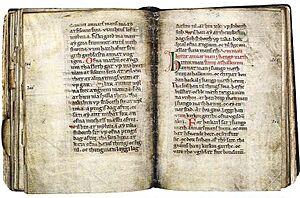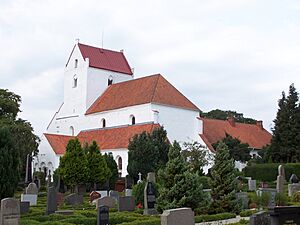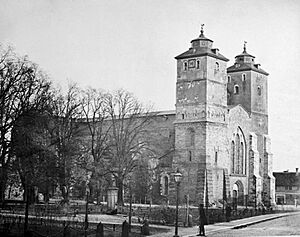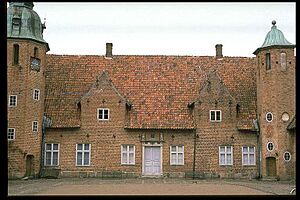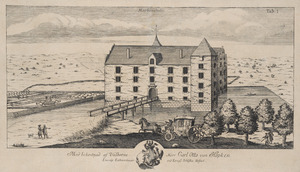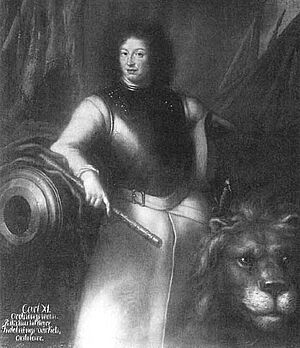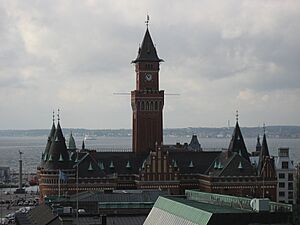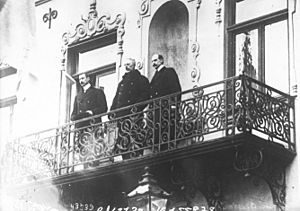History of Scania facts for kids
The history of Scania has been a long and interesting one. For many centuries, up until the 1700s, Scania was often a battleground. The kingdoms of Denmark and Sweden fought over who would control the Baltic Sea region. This struggle shaped Scania's past.
Contents
Life in the Viking Age
People used to think that society in Scania during the Viking Age was mostly made up of free farmers. They believed these farmers were equal and had a say in how society was run at meetings called Things. But new discoveries from places like Jutland and the Scanian plains have changed this idea.
It's now clear that wealth was not shared equally, especially from the early Migration Period. Large farms, much bigger than small ones, controlled most of the land. These farms were often grouped together in villages. This means only a small part of the population likely had full rights.
It seems more likely that society was made of different tribes. Each tribe had its own leader, often called a gode in Danish. Their power depended on how big and rich their tribe was. Scania had five main tribes. Each had its own leaders, called Thanes, and their own group of warriors. All these groups were under the King of Scania.
After Christianization: New Ways of Life
It was once thought that people started settling new lands in Scania before the Viking Age. But now, it seems this happened mostly after the Viking Age. This was when land was given to monasteries, bringing new ideas from other parts of Europe.
This led to a big change: people started farming much more instead of just raising animals. This meant clearing lots of land. It might also have been connected to freeing the thralls (enslaved people). Many new settlements were created during this time, with names ending in -torp, -rup, and -rød.
Scania is first mentioned in old writings from the 700s. These texts say it was part of Denmark. The Large Jelling Stone tells us that the people of Scania, like all Danes, became Christians. This happened because of the King of all Danes, Harald Bluetooth, around 985 AD.
The Scanian Law, which is the oldest of the Medieval Scandinavian laws, started being used in the early 1200s. It's special because it was written down in two ways: using Latin letters and also using Runes (in a book called Codex runicus).
As early as 1060, Dalby Church was built by Svend Estridsen. It was one of the first Danish churches made of stone. From 1104 to 1536, Lund was the main church center for Denmark, led by an Archbishop. The Danish national flag, Dannebrog, was kept in the Lund Cathedral for many centuries.
In 1332, the king of Denmark, Christopher II, died without much power. He and his brother had divided Denmark into many smaller parts. King Magnus IV of Sweden took advantage of this. He bought the eastern Danish areas, including Scania, for a lot of silver. However, the Danish king Valdemar IV of Denmark won Scania back in 1360. This was part of his plan to get back Danish lands that had been lost.
During parts of the Middle Ages, Scania was famous across Northern Europe for its herring fish. There was a big market, called the Scania Market, where the herring was sold.
The 14th and 15th Centuries
In the mid-1300s, the Black Death spread across Europe, affecting Scania too. The population dropped by about a third or even more.
Towards the end of the 1300s, the Kalmar Union was formed. This was an attempt to stand up against the Hanseatic League, a powerful group of trading cities. Queen Margaret was key to creating the Union. She became Queen of Denmark and Norway in 1387 after her only son, King Olaf II, died. Two years later, she helped the Swedes remove their disliked king, Albert of Mecklenburg.
Margaret's adopted son, Boguslaw, was crowned King of all three Scandinavian countries on June 17, 1397, in Kalmar. He was given the name Eric of Pomerania, which is why it's called the Kalmar Union. Queen Margaret remained the real ruler of the three kingdoms until she died in 1412.
King Eric founded the Scanian town now known as Landskrona. It was located in the middle of the Danish Øresund strait. In 1429, he started collecting the Sound Dues (Øresundtolden). This was a tax on ships passing through the strait, and it lasted until 1857. This tax brought a lot of money to his kingdom and made the town of Elsinore (Helsingør) very rich.
In 1425, "the Academy" was set up in the Franciscan monastery at Lund. It was like a medieval university. But it closed in 1536 when the Reformation reached Denmark.
Renaissance and Danish Rule
Rich Nobles and Their Castles
The time between 1536 and 1660 was a very good period for the nobles in Scania. They gained a lot of wealth and control over the economy. In 1536, the Crown took over lands that belonged to the church. These included rich lands from the former archbishopric at Hogestad and Snårestad, as well as lands from monasteries like Bosjökloster and Dalbykloster.
King Fredrik II also traded lands in Scania for lands closer to his own estate. This meant large areas in Scania ended up in the hands of local nobles. You can see their wealth in the private castles they built, like Rosendal Castle. By the 1600s, nobles owned about 54% of the 15,000 estates in Scania. In the Ystad area, around 80% of the farmland was owned by rich families by 1650.
Conflicts Over Control
Scania's location was very important. It was on the Scandinavian mainland but was part of the Danish kingdom. For centuries, this made it the main place where Denmark and Sweden fought for control of the Baltic region. This struggle was called dominium maris baltici. These two Nordic countries were at war with each other for about 500 years.
By controlling both sides of the Öresund strait and The Belts, Denmark could control who entered the Baltic Sea. This allowed Denmark to charge a tax, called the Sound Dues, on all foreign ships passing through the strait. This tax, started in the 1400s, was a huge source of money for the Danish king. Sweden hated paying it.
In 1645, a peace treaty (the Second Treaty of Brömsebro (1645)) said that Swedish ships would not have to pay the Sound Toll. But this changed in 1720, when the Treaty of Frederiksborg ended Sweden's tax-free status. Denmark continued to collect the Sound Toll until 1857.
In the winter of 1612, the Swedish King Gustav II Adolf attacked Scania. Over two weeks, he burned or destroyed 24 Scanian villages and killed most of their people. He did this without facing any enemy soldiers. The largest town destroyed was Væ. Two years later, the Danish King Christian IV built a new town nearby, called Christiansted (now Kristianstad). This was the last Scanian town founded by a Danish king.
Scania Becomes Swedish in 1658
After the Treaty of Roskilde in 1658, Scania and all Danish lands east of the Öresund strait became part of Sweden. This treaty followed a war between Denmark and Sweden (1657-1658). This war was part of a larger conflict that also involved Poland and some German states.
Soon after the treaty was signed, King Charles X Gustav of Sweden arrived in Helsingborg on March 5, 1658. He came to take control of the new areas. He was met by a group led by Peder Winstrup, the bishop of Diocese of Lund. The bishop, who was born in Copenhagen, quickly changed his loyalty to the new Swedish king. He later became a Swedish nobleman and stayed in his job until he died in 1679.
War with Denmark soon started again, this time begun by King Charles X Gustav. The result of this war and the Treaty of Copenhagen (1660) was that Bornholm went back to Denmark. The current border between Sweden and Denmark was set at this time. King Charles Gustav died from an infection during a visit to Gothenburg.
Scania, along with other areas called Scanian provinces, was put under a Governor-General. This person lived in Malmö. The first Governor-General was Gustaf Otto Stenbock. This type of government was used for areas that were not fully part of Sweden and were more likely to be attacked. The Governor-General was the top military leader and had four county governors working under him. In 1669, this system was stopped. But it was brought back when the Scanian War started in 1676.
In 1666, the University of Lund (also called Regia Academia Carolina) was started. This happened after Bishop Peder Winstrup suggested it. It was part of a plan to make the newly won areas more Swedish. There had been plans for a university in Götaland for a long time. With the new borders, Lund and Scania were chosen. The university closed during the Scanian War but reopened in 1682.
In 1676, during the Scanian War, Denmark took over Scania again. Many people from Scania joined the Danish army or fought with the Danes. These fighters were known as "friskydter" but are now more commonly called "Snapphanar" by the Swedes. The war between Denmark and Sweden from 1676 to 1679 was very hard on the people of Skåne. It ended mostly in a tie, but it caused a lot of damage and suffering for people. Landskrona Citadel became the main Danish base and place for new soldiers. Key moments were Swedish wins at the Battle of Lund in December 1676 and the Battle of Landskrona in July 1677. But the war lasted two more years.
Peace was made on September 2, 1679, with the Treaty of Fontainebleau (1679), thanks to France's help. The borders from the Treaty of Copenhagen (1660) were put back in place. Scania again became part of Sweden, even though many people there didn't want it. The treaty was confirmed again exactly two weeks later, on the 16th, as the Treaty of Lund.
At first, the Roskilde peace treaty (Section 9) said that Scania would have its own rules. An extra agreement, signed in Malmö in 1662 (the Malmö Recess), promised that Scania's old laws and special rights would continue. This agreement also said that Scanian nobles, priests, and farmers could send people to the Swedish parliament.
However, in 1680, Sweden began its first period of absolute monarchy. King Charles XI convinced the Swedish parliament (the Riksdag of the Estates) to declare him "a Christian ruler with absolute power." In 1682, the parliament gave the king unlimited power to make laws without their approval. Soon after, the agreement from the Malmö Recess was ignored. A tougher program to make Scania more Swedish was started. This aimed to make everything the same across the Swedish kingdom. Scania was allowed to keep its old laws until 1683. Then, the Swedish government convinced the Scanian nobles to give up their old laws and rights. This was a condition for allowing Scanians to have people in the Swedish parliament.
Many Swedish politicians, artists, and scholars worked to create an image of the king as a special leader chosen by God. He was shown as the "Lion of the North," a symbol first used for Gustav II Adolf. This propaganda aimed to convince Swedes of the king's power. It also showed Sweden to the world as a powerful country with great wealth and military strength. Many artworks from this time show Charles XI as a winning warrior in Scania. In a large painting in the Stockholm Royal Palace, Charles XI is shown with "the goddess of Scania" at his feet.
Blekinge and especially Halland were slowly removed from the Skåneland area. They became fully part of the Swedish Kingdom. The four counties of Scania were joined into one county. However, Blekinge was allowed to stay part of the Lund church area, and it still is.
By 1693, Scania became a special area within Sweden, not fully integrated. It kept its own parliament, called the Lantdag.
The last battle between Denmark and Sweden over Scania was the Battle of Helsingborg (1710) during the Great Northern War. In March of that year, the last Danish troops left the province.
In July 1720, a peace treaty between Sweden and Denmark again confirmed that Scania was part of Sweden. Scania had already been divided into two counties the year before: Malmöhus County (named after Malmöhus Castle) and Kristianstad County.
These two counties got governors and an administrative system just like other Swedish counties. However, during the Napoleonic Wars, when Sweden and Denmark were fighting, Sweden brought back the Governor-General position. From 1801 to 1809, Johan Christopher Toll was the Governor-General of Scania. The county governors of Kristianstad County and Malmöhus County reported to him.
King Charles XII lived in the city of Lund for two years after he returned to Sweden from the Ottoman Empire in 1716.
After the Peace Treaty of 1720
In July 1720, a peace treaty between Sweden and Denmark once again confirmed that Scania was part of Sweden.
A major land reform, called "Enskifte," happened around 1700-1800. At that time, Scania's population had just passed 250,000 people. Rutger Macklean was the first to put this reform into action in the 1780s. He did this on his large estates around Svaneholm Castle. But he also burned down farmers' villages, which caused problems later when the reform was used everywhere.
Jean-Baptiste Bernadotte, who would become King Charles XIV John, arrived in Helsingborg on October 20, 1810. He was on his way from Paris to Stockholm.
In 1811, there were revolts in different parts of Sweden. This was because farmers were being forced to join the army. At the Klågerup shootings, 30 to 40 civilians were shot and killed by the military. Several hundred were taken prisoner or wounded. Afterward, two men had their right hands cut off and were then beheaded in Malmö's Stortorget square. Many others were also physically punished.
The first horse-drawn railway in Sweden (with wooden rails) opened in 1798 at Höganäs. It connected the coal mine to the harbour. In 1856, one of the first public railways in the country opened between Malmö and Lund.
By 1863, the population of Scania had reached 500,000 people.
In the 1800s, Scania became the birthplace of the Swedish Social Democratic Party. This happened when August Palm gave his speech "Hvad vilja socialisterna?" ("What do the Socialists want?") in Malmö in 1881. He also started the newspaper Folkviljan there.
Train ferries started sailing between Helsingborg and Elsinore (the HH Ferry route) in 1892. From 1909, they also sailed between Trelleborg and Sassnitz, Germany. These ferries later started carrying cars and trucks too.
On December 18 and 19, 1914, the Three Kings Meeting was held in Malmö. This meeting was to confirm that the Scandinavian countries would stay neutral during World War I. The Swedish King Gustav V, the Danish King Christian X, and the Norwegian King Håkon VII (Christian X's brother) met with their foreign ministers in Malmö. This meeting also showed that Sweden fully accepted Norway leaving the Swedish-Norwegian union in 1905. The Swedish King in 1905, Oscar II, had not accepted Norway's independence. But by 1914, his son Gustav V was king. He wanted to improve relations between the Swedish and new Norwegian royal families. Since this meeting, the royal relationships between Sweden, Denmark, and Norway have been excellent.
The first public flight school in Sweden was set up in 1915 at Ljungbyhed by Enoch Thulin. From 1926 to 1996, it was the flight school for the Swedish Air Force. Today, commercial flight training happens at Ljungbyhed Airport, which is one of the world's oldest active airports. In 1924, the world's shortest international air route opened from Malmö's Bulltofta Airport to Copenhagen, Denmark. They used Junkers F 13 planes.
After the February Revolution in Russia in 1917, Germany hoped for a separate peace treaty with Russia. But the new Russian leader, Alexander Kerensky, said no. So, Germany gave the Russian communist leader Vladimir Lenin and his friends in Switzerland safe passage through Germany. They hoped Lenin and the communists would cause problems in Russia, leading to peace on the Eastern Front. In August 1917, Lenin and his group arrived in Scania. This important journey happened on the train ferry line between Saßnitz (Germany) and Trelleborg (Scania in Sweden).
Between 1930 and 1939, the Saxtorp TT-races were held. These were motorcycle races similar to those on the Isle of Man. Nine out of ten of these races attracted huge crowds, over 100,000 people, sometimes up to 160,000. No other sports events in Sweden have seen crowds this large. The 1937 race only had 80,000 people because of heavy rain.
The first motorway in Sweden opened in 1953. It connected Malmö and Lund (today it's part of European route E22).
For the 1958 FIFA World Cup, Malmö Stadion was built. It was used for both football and track and field. The first game of the championships was played there, where West Germany beat Argentina 3-1. A few games were also played at Olympia in Helsingborg.
In the mid-1970s, the population of Scania passed one million people.
The first aircraft hijacking in Sweden happened in September 1972 at Bulltofta Airport in Malmö. It involved Croatian terrorists.
Malmö and the old Malmö Stadion were among the four stadiums that hosted the UEFA Euro 1992. Three games were played at Malmö Stadion: Denmark vs. England (0-0), England vs. France (0-0), and France vs. Denmark (1-2).
A new way of organizing the government was set up in 1997. Kristianstad County and Malmöhus County were joined together. They formed Skåne County with 33 municipalities.
In July 2000, the Öresund Bridge was opened. This created a permanent rail and road link between Sweden and Denmark.
At 6:22 AM on December 16, 2008, a very unusual earthquake hit Scania. It was also felt in large parts of Götaland, Denmark, and northern Germany and Poland. Its center was near Sjöbo. It measured 4.8–4.9 on the Richter Scale. According to the closest seismic station in Berlin, Germany, it was the worst earthquake in Sweden for a century or more. Sjöbo is less than 400 km from Berlin.
Pope Francis visited Scania on October 31 and November 1, 2016. His 24-hour visit marked the 500-year anniversary of the start of The Reformation. A special church service was held in the 900-year-old Lund Cathedral. The next morning, the Pope led a Catholic mass at Malmö FF's football stadium. During the service in the cathedral, the Pope and the head of the Lutheran World Federation, Bishop Dr. Munib Younan, signed an agreement. In it, Lutherans and Catholics promised to focus more on what brings them together rather than what divides them.
By 2015, the population of Scania had grown to over 1.3 million people.



